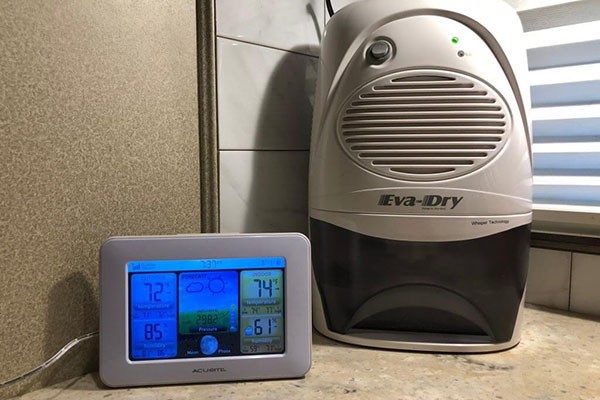RVs offer an amazing opportunity to travel the country but can get uncomfortably humid depending on how many people are living in it and where it is taken. Activities like cooking and showering can also add to the moisture level on board and make the atmosphere unbearably muggy. RVs that are parked for long periods of time may also retain too much humidity that can damage the fittings inside. The solution is a tool made specifically for smaller spaces, and we’ll break down what you need to look for in the best dehumidifier for RV use.
There are challenges that come with dehumidifying an RV. One is that space is at a premium, so you need a compact unit. Another is that the vehicle is often moving, so having a bucket of collected water sloshing around can lead to spills. There are several models of RV dehumidifier that take these issues into account, but first, let’s look at the different mechanisms utilized to handle moisture in relatively small spaces.
There are several different mechanisms by which a dehumidifier can work. Models made specifically for smaller spaces may use any of the following.
Refrigerated Coils
The electric type of dehumidifier typically uses a compressor to chill metal coils, and a fan to direct air over the coils. As the room’s air passes over the cold coils, moisture is drawn from it and dripped into a containment basin. The water then remains in the bucket until it is removed and emptied, or else it is drained through a hose directed into a sink, through a floor drain, or out a window. The water may flow under the influence of gravity from a higher point to a lower drain. Some models have an included pump that can push water upward, making it even easier to drain wherever you choose. Electric models need to be plugged in to an outlet to work.
Desiccant
Other dehumidifiers use absorbent silica gel beads to pull moisture from the air. They do not need electricity to work, but they do have a capacity at which they stop working until they can be dried out again. To “recharge” desiccant dehumidifiers, you will typically need to plug the unit into an outlet. It will heat up enough to cause the collected water to release back into the air, drying the beads and getting them ready to start absorbing humidity again.
The benefit of this method for RVs is that desiccants hold onto their moisture and can’t spill. The downside is that they release their moisture back into the air during recharging, so it is vital that this happens outside of your RV or else the internal humidity will go back to where it was. Desiccants also don’t have quite the same capacity as electric models, so you may need several to cover the required space.
Air Dryer
For smaller spaces, an air dryer may just do the trick. It doesn’t use coils or desiccant, but rather takes advantage of convection. These dehumidifiers simply heat the air nearby past the dew point. The dry, warm air then rises, and cooler, wetter, denser air sinks to take its place. These are great simple machines that rarely break down because there are no moving parts, just a heating element.
However, they may not be ideal during the dog days of summer when added heat is not very welcome. It should be noted that all electric dehumidifiers will generate a bit of heat as a byproduct of their operation. Whether you choose an air dryer or dehumidifier depends on how large and humid a space you want to treat.
Things to Look for in a Dehumidifier for RV
The three main criteria for the best RV dehumidifier are sufficient water capacity, compact size, and low noise level. Beyond that, there are other optional features that may appeal to you.
Additional features of electric models
- Automatic shut off
- Clear viewing window to determine water level
- Integrated pump
- Drain hose
- Built-in humidistat
- Auto restart
Additional features of desiccant models
- Colorant added to beads to indicate fullness
- Plug in recharging
- Manual recharging in microwave or oven
- Lightweight
- Low power consumption
You will also want to consider the following when choosing the best dehumidifier for you.
Extraction rate
Extraction rate refers to how much moisture a dehumidifier can extract from the air over what period of time. Electric dehumidifiers always have a higher extraction rate than desiccants, so may be the way to go if your RV is quite humid. If you just want to keep closets and areas where wet clothes are hung a bit drier, you can go with a desiccant dehumidifier for each space within the RV that needs it.
Power consumption
This is a tricky thing to compare. Electric models need power while they are working, which desiccant types usually do not; they do, however, usually need to be plugged in while recharging. There are also hybrid dehumidifiers that contain desiccant gel beads but also use a fan to pull air across them. These must be plugged in during operation and tend to use more electricity while dehumidifying than straight electric models. Our best advice is to look for an Energy Star rated appliance, no matter what type you choose.
Timer function
If you have portions of the day that are more humid than others, it may be helpful to get a dehumidifier that can run on a timer. That way, you’ll be able to schedule it to work when you most need it, and save energy at other times, such as when you’re on the road and air conditioning can help to manage air humidity levels.
Laundry setting
This feature is available in some electric models. It boosts the extraction rate when you have wet clothes drying nearby. This can be handy if you constantly have wet swimsuits steaming up your RV.
Portability
Units designed especially for RVs are typically small, and are wider at the base to prevent tipping. They are also often lightweight enough to move around as needed, but some tip the scale at up to 26 pounds, so make sure you know the weight before purchasing. If you plan to move your unit around very much, stick with a lighter model.
Now on to the top rated RV dehumidifier products!
Top 5 Dehumidifier for RV Use Comparison
|
Model |
Style |
Capacity |
Coverage |
Warranty |
|---|---|---|---|---|
|
Davis Air-Dryr |
Air dryer |
n/a |
1000 cubic feet |
One year |
|
BARSKA 150G |
Desiccant |
unknown |
10 cubic feet |
One year |
|
Hysure 1500ml |
Electric |
1500 ml |
269 square feet |
Two years |
|
Ivation 13-Pint |
Electric desiccant |
½ gallon |
270 square feet |
One year |
|
Trustech |
Electric |
41 ounces |
220 square feet |
One year |
5 Best Dehumidifier for RV Use Reviews
Learn more about the features and capacity of each of our favorites with the following in-depth RV dehumidifier reviews. You may find that more than one of them is required to really do the job you need.
Davis Instruments Air-Dryr 1000 Dryer
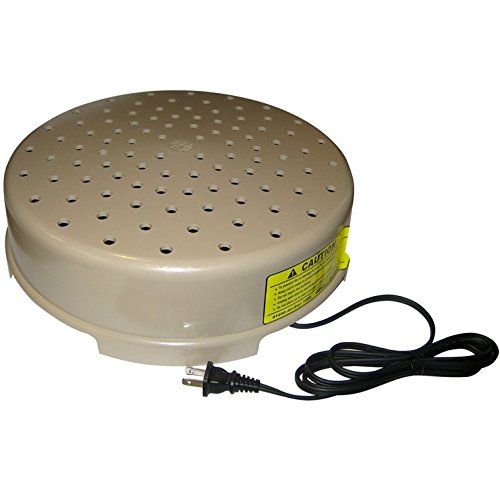
We wanted to include an Air Dryr 1000 review because it works a little differently than most dehumidifiers. This is a small device that simply warms the damp air around it to above the dew point (where moisture is held in suspension). Warm air rises and the cooler, damp air replaces it. It works the same way as the heater in your home, which you have probably noticed keeps the air in your home very dry. This type of dehumidifier is also good for managing cold drafts.
Though it warms up, it is always safe to touch and compact enough to fit into relatively tight spaces. It is okay to use 24 hours a day, and takes only as much electricity as a light bulb. It also works silently, with no fan. Instead, it relies on natural convection (the rising of hot air and sinking of cold air) to create circulation. Should air flow be blocked for some reason, the device does have an auto shutoff feature.
Built with neutral beige polycarbonate housing, it is a strong and durable solution for humidity in enclosed spaces such as RVs. Because of the way it works, there is no water containment involved so you won’t ever have to pay attention to that or worry about spills. That makes it ideal for moving vehicles like RVs or even boats.
SPECS:
- 14 x 14 x 5 inches
- 2.2 pounds
- One year warranty.
PROS
- Low energy use
- Never needs emptied
- Silent operation.
CONS
-
- Depending on humidity, may not be a standalone solution
- Will warm up the space slightly
- Does best in enclosed spaces.
2 BARSKA 150G Dehumidifier, Blue, Small
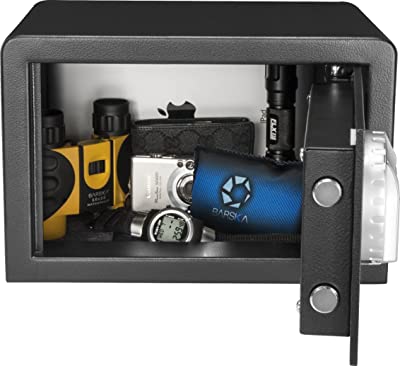
This cute desiccant dehumidifier comes in the form of a pillow that you can toss into closets, drawers, or onto furniture in a damp room. It works best as RV storage humidity control to protect items that can be damaged by excess moisture, such as photos, electronics, ammunition, or clothing. It is not made to pull a ton of moisture from the entire RV, but is ideal if you find your crackers are always going stale or your clothes smell of mildew.
Compact and attractive, the Barska uses silica gels beads that change from blue to pink when they are full. To recharge, simply place the pillow in the microwave for four minutes. That is the extent of the electricity needed to power this dehumidifier, making it a great energy saving choice. Obviously, it is highly portable as well, so can come along in suitcases or tents if needed, or just keep working in your RV when it is parked.
The desiccant inside can be filled and recharged over and over for many years, but will gradually hold less moisture each time. We recommend buying several to place in strategic locations throughout your recreational vehicle. These can be good as a dehumidifier in stored RV units, because it uses no power and can be left alone for months.
SPECS:
- 5 x 3.5 x 1.2 inches
- 7 pounds
- One year warranty.
PROS
- Uses almost no energy (only to recharge in microwave)
- Small and attractive
- Long useful lifespan.
CONS
-
- Only meant for small enclosed spaces
- Will melt if microwaved too long during recharging
- Color changing indicator not always reliable.
Hysure 1500ml Dehumidifier, 2200 Cubic Feet, Compact and Portable for Damp Air, Mold, Moisture in Home, Kitchen, Bedroom, Basement, Caravan, Office, Garage
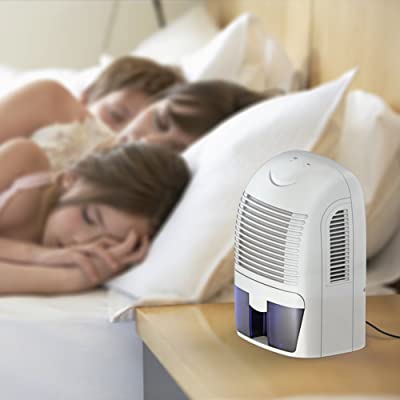
Moving on to an electric model that may be necessary if you are dealing with a great deal of humidity, this Hysure model is both compact and quiet. It uses peltier technology rather than a compressor to pull air across the coils, and therefore can run at a peaceful 42 dB level. It is able to pull up to 55 ml per day of water from the air, and the collection bucket will hold up to 1500 ml before it needs to be emptied.
The unit is energy efficient and has a spill-proof reservoir to make it safe for use in a moving RV. It has an auto shutoff feature as well so that it turns off and lights an LED indicator when it is time to empty the bucket.
Though it is small and easy to fit into tight spaces, do make sure that the intake and exhaust vents are not blocked when placed. It is ideal for spaces between 162- 269 sq. ft. All in all, this is a stripped down model that doesn’t have a lot of extra features but does its primary function quite ably.
SPECS:
- 13 x 9 x 6.6 inches
- 5 pounds
- Two year warranty.
PROS
- Spill proof reservoir
- Compact and lightweight
- Quiet operation
CONS
-
- No integrated humidstat
- Will warm up the space slightly
- May take a bit of time to clear humidity upon first use.
Ivation 13-Pint Small-Area Desiccant Dehumidifier Compact and Quiet – With Continuous Drain Hose for Smaller Spaces, Bathroom, Attic, Crawlspace and Closets – For Spaces Up To 270 Sq Ft, White
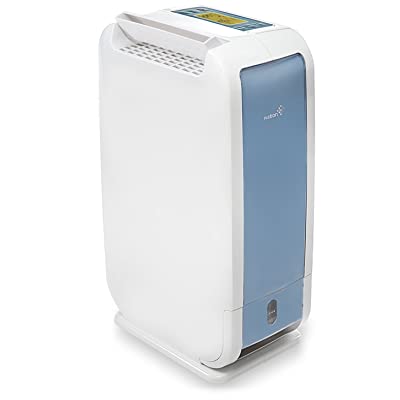
The Ivation desiccant dehumidifier has all the bells and whistles you might expect in a compressor model and is specially designed for areas in motion, too. It works via air pulled over desiccant material by a rotor. The desiccant absorbs moisture from the air, and then is heated to release the water again into a containment unit. It has a user friendly LCD display that allows adjustment of fan speed, timer/sleep mode, and even screen brightness. This model is made to work in temperatures as low as 33°F, much colder than the average compressor dehumidifier can manage. It also releases slightly warmed air upon use.
The auto tilt shutoff feature is triggered by sudden movement, preventing spills while your RV is in motion. The containment tank can hold up to ½ gallon of water, has a clear viewing window, and is easily emptied using the attached handle. However, this model is a RV dehumidifier with drain hose included for continuous drainage. There are adjustable vent covers to direct air flow toward especially damp areas, such as the shower room or where clothes are drying.
Choose Ivation if you would like to dehumidify the entire RV space, as it can handle areas up to 270 square feet. Set your desired humidity level in 5% increments and monitor it with the built-in humidistat. With whisper quiet operation, timer function, and variable fan speeds, your dehumidifier works hardest for you when you need it but won’t disturb sleep or concentration at any time. It also has an auto restart feature so that you don’t have to worry about turning it on again after periods of power outage.
SPECS:
- 10.6 x 6.8 x 17.5 inches
- 11 pounds
- One year warranty.
PROS
- Works quickly and quietly
- Loaded with features
- Can dehumidify a whole RV.
CONS
-
- Humidstat only measures to nearest 5%
- Will warm up the space slightly
- Heavier than other models.
Trustech Dehumidifier – 41oz Capacity Electric Dehumidifier Portable Mini Air Dehumidifiers Auto Quiet up to 220 sq ft Anti Overflow Dehumidifier for Home Bathroom Bedroom Closet Office Basement
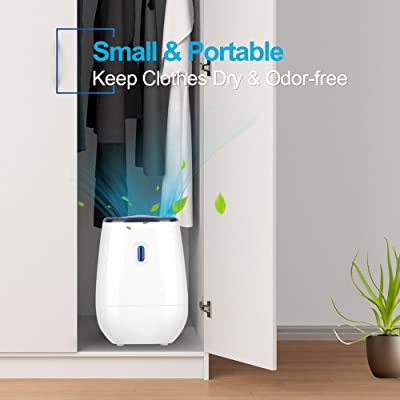
Finally, a traditional compressor model, this Trustech dehumidifier features powerful efficiency in a small package. It uses two air inlets to pull damp air from all around, and cover an area of about 220 square feet. It can pull 250 ml per day from the air, and hold up to 41 ounces of water before needing to be emptied. It is super quiet, running at only 30 dB.
The auto shutoff feature guarantees that your dehumidifier will not overflow, and the yellow LED indicator light provides a visual reminder when it’s time to empty. It can be used for up to 48 hours straight if need be. And at less than 4 pounds, this device is compact and easy to move around from space to space.
SPECS:
- 12.8 x 9.8 x 6.5 inches
- 3.53 pounds
- One year warranty.
PROS
- Very quiet operation
- Attractive styling
- Dual intake ports.
CONS
-
- No humidistat
- No timer function
- Lower water capacity.
Maintaining Your Dehumidifier
The work required to keep your dehumidifier in great shape depends a lot on the type you choose and the features it offers. More complex units with a compressor may pull more water, but they are also prone to breakdown and will eventually need to be repaired or replaced.
The simplest form of desiccant humidifier, such as the Barska pillow, needs no regular maintenance at all beyond recharging it for a few minutes in the microwave. However, the capacity of the silica gel beads to absorb water will diminish over time. Following are some things you may need to address in terms of maintaining your dehumidifier.
Keep it Clean
Maintenance of your RV dehumidifier starts with basic cleaning.
Vents
All electric dehumidifiers use a fan of some sort to pull in and then exhaust the moist air. Dust and floating debris comes in right along with the air and can build up on intake and exhaust vents. When these passages become clogged, the motor struggles to get enough airflow, which leads to burnout. Dusting out the vents frequently helps to preserve the life of your device.
Water Collection Tank
You know you need to empty the water collection tank when it’s full, but this is also a good time to give it a quick cleaning. Use dish soap and water or even just a disinfectant wipe, but don’t skip this step. Mold and mildew can grow in moist environments – this is part of why you bought the dehumidifier in the first place. Unfortunately, the unit itself is also just as prone to growing yucky stuff when it is left in a damp condition constantly.
Air Filter
Some of the more basic electric units may not have this, but if yours does, it needs to be cleaned or replaced when it gets dirty. For the same reason that vents must be addressed, a dirty filter keeps the machine from working to its full potential. Air filters are also helpful in terms of purifying the air in your space, as drier air that gets vented comes out fresh and free of allergens and dust particles.
Check Connections
As with any machine, the internal components must be properly attached to work efficiently, or in some cases, at all. Checking out all the various working pieces of your dehumidifier can help you determine whether it is functioning at its best. Sometimes it can seem like the unit is running, but it may not be pulling as much moisture as it could.
Coils
Dehumidifiers with coils aren’t made to work in very low temperatures, so if yours has been exposed to freezing, the coils could be affected. Some dehumidifiers are made with a hot gas component that thaws out frozen coils, but most are not. Repeated freezing and thawing of the coils can shorten their useful life, and create hot spots along their length where they won’t be effective at pulling moisture from the air.
Similarly, coils that come unseated due to frequent road vibration also won’t work very well. Sometimes loose coils can be reseated by hand, but often you will want to have them checked out by a professional.
Electric Cords
Electric cords that are frayed are very dangerous to use. The delicate wires inside the rubber outer coating can also be broken easily by bending it repeatedly, keeping it too taut while plugged in, or forcing it to bend sharply. Most lower cost electronics don’t have a power cord with connections at both ends (computers and printers often do). But if yours does, it is relatively easy to buy an aftermarket replacement for a damaged cord. It’s still better to ensure that your dehumidifier’s cord is out of the way so that it won’t be tripped over, and has some slack in it to protect the wires inside.
Seams
Desiccant style dehumidifiers with seams, either fabric, plastic, or metal, are prone to splitting under pressure. The last thing you want is thousands of silica gel beads all over the place when a seam splits unexpectedly. They are really tough to clean up! Take the time to examine all seams carefully every time you recharge your dehumidifier, and secure any spots that look like they may separate.
Limitations of RV Dehumidifiers
Even the best dehumidifier won’t be able to keep up if there is a water leak or other source of pooled water. If you have leaking pipes anywhere on board, or cracks where rain can get into your RV, take the time to get those fixed. None of the compact units on our list are made to handle standing water, and you are likely to get mold or mildew growth pretty quickly.
Having a dehumidifier that is designed with small spaces in mind can make a huge difference in the comfort of your RV for trips. A dehumidifier in stored RV is also great for keeping your recreational vehicle nice and dry while not in use, so that anything that remains within stays in great shape, and there is no mold or mildew to contend with before getting out on the open road. We hope that we have given you the information you need to purchase the best dehumidifier for RV use and to enjoy your trips that much more.

